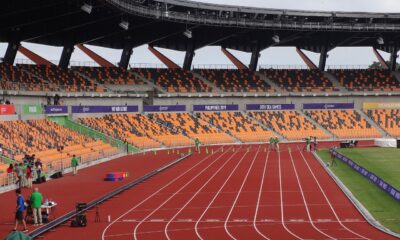Athletics
How to Sprint Faster

How to Sprint Faster
With the end of the rugby and football season, now is a great time to concentrate on your speed prior pre-season.
To sprint faster, you can focus on improving your technique, strength, and conditioning. Here are some tips to help you sprint faster:
- Warm Up: Begin with a thorough warm-up routine that includes dynamic stretching and mobility exercises to prepare your muscles and joints for the intense sprinting activity.
- Proper Sprinting Technique: Pay attention to your sprinting technique, as it plays a crucial role in maximizing your speed. Key elements to focus on include:
- Start: Practice explosive starts from the blocks or a standing position. Work on your reaction time and driving your legs forward with power.
- Arm Swing: Maintain a relaxed arm swing with your elbows bent at around 90 degrees. Your arms should move in a straight line from the shoulders to the hips, driving back and forth rhythmically.
- Knee Drive: Lift your knees high, driving them forward with each stride. This action helps generate power and momentum.
- Stride Length and Frequency: Strive for longer strides by pushing off forcefully from the ground with each step. Increase your stride frequency by taking shorter recovery steps.
- Body Position: Maintain an upright posture with a slight forward lean. Avoid excessive backward leaning or bending at the waist.
- Strength Training: Incorporate strength training exercises into your routine to build power, explosiveness, and overall strength. Focus on exercises that target the lower body, such as squats, lunges, deadlifts, and plyometric exercises like box jumps and explosive jumps.
- Plyometric Training: Plyometric exercises help improve your ability to generate explosive power. Incorporate exercises like jump squats, bounding, depth jumps, and skipping into your training program.
- Resistance Training: Utilise resistance training methods to enhance your sprinting power. Sled pulls, hill sprints, and resistance band training can help build strength and speed.
- Sprint Intervals: Incorporate sprint intervals into your training routine. Alternate between short bursts of all-out sprinting and active recovery periods. This method helps improve your speed endurance and anaerobic capacity.
- Flexibility and Mobility: Maintain good flexibility and mobility to ensure proper movement patterns and prevent injuries. Regularly stretch your muscles, paying attention to areas such as hips, hamstrings, and calves.
- Conditioning: Develop your cardiovascular fitness through various forms of conditioning, such as high-intensity interval training (HIIT) or tempo runs. Improving your overall fitness level will enhance your sprinting performance.
- Rest and Recovery: Allow sufficient time for rest and recovery between training sessions to avoid overtraining. This helps prevent injuries and allows your body to adapt and grow stronger.
- Seek Professional Guidance: Consider working with a coach or a professional trainer who can provide personalized guidance, analyse your technique, and design a training program tailored to your needs and goals.
Remember, consistency and dedication are key. Train regularly, focus on quality over quantity, and gradually progress your training intensity to improve your sprinting speed.
Read more on sports below:
-

 News1 month ago
News1 month agoThe Best Male Tennis Players of All Time
-

 Uncategorised1 month ago
Uncategorised1 month agoWhat Dinosaur Has 500 Teeth?
-

 News1 month ago
News1 month agoThe Fastest Rugby Players Ever
-

 Football1 month ago
Football1 month ago10 of the most underrated footballers in the world right now
-

 Football1 month ago
Football1 month agoThe Best Penalty Takers of All Time
-

 Football1 month ago
Football1 month agoPlayers with the most goals in a Premier League season
-

 Football1 month ago
Football1 month agoWho is the Fastest Football Player in the World?
-

 Football1 month ago
Football1 month agoChelsea’s Possible Lineup For Next Season





















